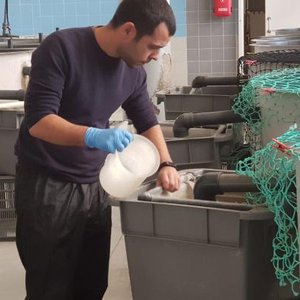Scientists from the Roslin Institute developed extensive genetic resources detailing the DNA of oysters and used them to help address the challenges this species faces in terms of conservation, restoration and aquaculture.
Researchers have found two areas of the oyster genome are significantly associated with faster growth. The incorporation of genomic information into breeding schemes could be a cost-effective way of enhancing growth traits such as weight and shell size in oysters, scientists concluded.
A separate study, led by scientists from the University of Santiago de Compostela and involving Roslin experts, discovered that variations in a region of oyster DNA may be associated with tolerance to a deadly parasite.
Reference genome
To help understand all the genetic information in their studies, the researchers decoded the complete DNA code of the European flat oyster. Two high-quality reference genomes were separately built to the chromosome level by the Roslin team and scientists from Sorbonne University in France. Both genomes have been published in Evolutionary Applications and are already being widely used by oyster researchers in Europe.
Growth traits
Scientists analyzed the genome of the European flat oyster to look for variations and assess whether growth traits are under genetic control and could therefore be improved through selective breeding. This research, published in Frontiers in Genetics, concluded that it is feasible to genetically improve growth traits in oysters.
Parasite tolerance
In a separate study, scientists compared the genome of oysters that had not been exposed to the deadly parasite Bonamia ostreae with that of long-term affected populations. The team looked into areas of the oyster genome previously linked to resilience to the parasite and found an area associated with resilience to the parasite.
“High quality reference genome assemblies are of immense value when applying genetic tools in aquaculture and conservation. Our genome assembly enhances the resources available for flat oyster research, supports ongoing conservation efforts and selective breeding programs, and improves our understanding of bivalve genome evolution,” said Manu Gundappa, post-doctoral research fellow, Roslin Institute.
“Our study shows that breeding programs for flat oyster aquaculture and restoration would benefit from the incorporation of genetic information to identify the best candidates for breeding, thereby fast-tracking genetic progress in key traits in a sustainable way,” said Carolina Peñaloza, post-doctoral research fellow, Roslin Institute.
Chromosome level reference genome for European flat oyster by Gundappa et al.
Genome-wide association and genomic prediction of growth traits in the European flat oyster by Penaloza et al.
Two parallel chromosome-level reference genomes to support restoration and aquaculture of European flat oyster Ostrea edulis by Bean et al.













